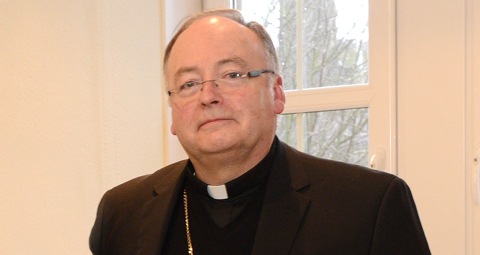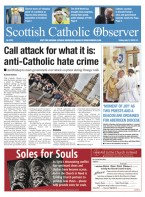BY Amanda Connelly | July 13 | ![]() 0 COMMENTS
0 COMMENTS ![]() print
print

Parliament’s Time for Reflection is anodyne, politically correct and ignored by MSPs, bishop says
Few parliamentarians listen to the Words of the Gospel when spoken, Bishop Stephen Robson of Dunkeld said during a pilgrimage homily on July 5.
The bishop was speaking on the 700th anniversary of the consecration of St Andrews Cathedral as pilgrims gathered for the annual New Dawn in Scotland event.
Time for Reflection takes place once a week in parliament, and is usually delivered by someone from a faith community such as a priest or minister.
“Who listens to the words of the Gospel in parliament now?” the bishop asked during his homily, which was filmed by parish media group Sancta Familia Media. “Anyone who has been invited to give the daily reflection at Holyrood will tell you how few parliamentarians come to the chamber at the time of the day, and how even fewer come and listen to what’s being said.
“The messages rendered there by ecclesiastics from all traditions in Scotland are so morphed and doctored so as not to challenge and offend that they’re totally anodyne and say nothing to our government.
“The language is often truncated and peppered with politically correct language.”
He added: “The social engineering experiments which emanate from our parliaments have brought us many radical new institutions and forms of human community and family alien and unrecognisable to the Scriptures.”
Catholics from near and far listened to Bishop Robson as they joined New Dawn in Scotland’s annual St Andrews Pilgrimage and Rosary procession in honour of Our Lady and St Andrew.
Many gathered for the annual event, which falls during New Dawn’s Catholic Pilgrimage Conference, which has been held each year for the past nine years.
Held on the feast of Our Lady of Aberdeen, this year proved to be very special, as the procession also fell on the 700th anniversary of the consecration of St Andrews Cathedral, on July 5, 1318.
Following the theme of Mary, Mother of the Church, the day began at 9.30am, with the veneration of the statue of Our Lady and relic of St Andrew at St James’ Church in St Andrews.
The faithful then joined in the Rosary procession at 10.45am from St James’ Church, in beautiful sunshine, bearing New Dawn banners and the statue of Our Lady, before the celebration of the open-air Mass at the ruins of St Andrews Cathedral.
The many pilgrims, young and old, who gathered there were led in the celebration of Mass by Bishop Robson and other members of clergy.
“The shrine containing the relics of the apostle Andrew were venerated here since the eighth century,” the bishop said during his homily.
“This was a beacon of medieval Faith and pilgrimage of enormous proportions, ranked highly amongst the greatest and largest pilgrim shrines in Europe alongside Rome, the Holy Land, Canterbury, Santiago, Cologne, and Walsingham.
“Here in St Andrews, records and annals show a civic population who were caught up in the great celebrations of the liturgical calendar, the eternal cycle of feasts and celebrations.”
There was a particularly fitting sight to behold in the blue skies above, as a St Andrew’s Cross appeared in the clouds during the Liturgy of the Eucharist.
Bishop Robson used his homily to give a passionate address on issues of Church and state.
“I must say I’m most grateful to the New Dawn movement for having the renewal weeks here in St Andrews, where they have drawn our attention to the Catholic roots of our past in this beautiful and historic town,” Bishop Robson continued.
“But what of this great cathedral complex, now ruined, and which has become for many simply an historical artefact to be marvelled at, but nonetheless consigned to the annals of history?
“This holy place serves to remind us of a once-living, influential and powerful witness to the Gospel at the highest levels of our land, calling our attention to adoration and prayer, whatever its political connections to the past history of our country.
“The shell of this great church resembles the great monastic settlements dotted about the various, once-sacred centres and shrines of Scotland. It seems to me to be, on the one hand, like a great metaphor for the influence the Church once experienced in this land and now lost.
“Brothers and sisters, we are in a period of great confusion and punishment and chastisement.
“This is an unpopular message but we deserve it, we need to heed it, we need to respond to it, all of us. This ruined cathedral, like the Church herself is brought low.
“It contains the memories of a glorious and sometimes inglorious past. We have suffered before and we have been heavily chastised by God before and we’ve deserved it. But God never closes the door on us; God never forgets us. For Christ has triumphed and goes back on His promises never.”
The day continued with various workshops held between 3pm and 4pm, with praise and worship at 7pm.
Announcements and some entertainment were held at 7.30pm, and a talk from John Hesketh at 7.45pm, before the day concluded with prayer ministry at 9pm.
Thursday’s events came as part of the annual New Dawn Catholic Pilgrimage Conference, which was held in St Andrews at Madras College.
It featured the celebration of daily Mass and talks on a number of subjects, which discussed a range of topics relevant to living out the Faith daily during times of hardship, as well as a programme for children and young people.
Vernon Robertson was invited as the main speaker from Canada, having left Scotland in the late 60s an atheist and now a leading Canadian Catholic Evangelist, while other speakers included Professor Ian Bradley, Ros Powell, John Hesketh and Anthony Gielty.
Each brought insight in various aspects of the Faith, such as the Holy Spirit, Reconciliation, healing, Our Lady and evangelisation.
Many present praised the wonderful conference, among them young people, parents, families, and friends, noting the chance to come together, to join in prayer, and learn more about their Faith, through all that took place over the course of the conference.
New Dawn, which began in Walsingham in 1987, has spread to a number of different countries and aims to showcase the Church in all its splendour.











